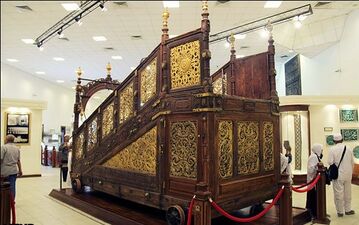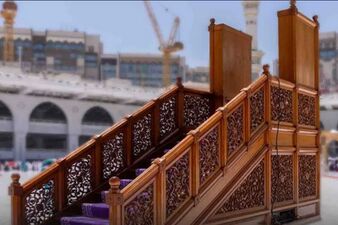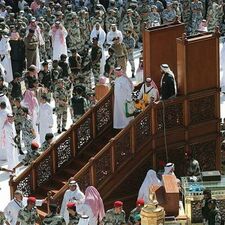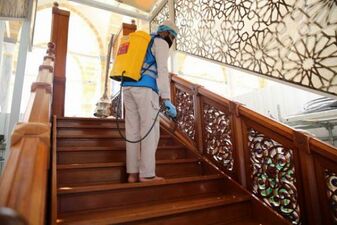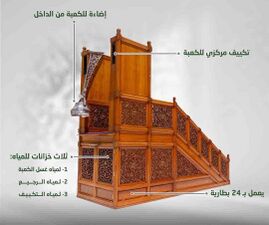External staircase of Ka'ba
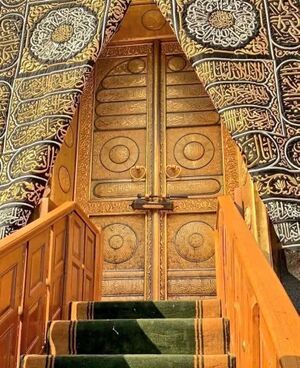 External staircase of Ka'ba | |
| General Information | |
|---|---|
| Other Names | External ladder of the Ka'ba , Stairway to the entrance of the Ka'ba |
| Place | Mecca, Masjid al-haram |
| History | |
| Founder | Quraysh |
| Events | Recitation of the famous sermon of the Prophet of Islam during the Conquest of Mecca in the year 10 AH on top of the external stairs of the Ka'ba • Narration of a hadith by Abu Dhar on the virtues of the Ahl al-Bayt (AS) on top of the external stairs of the Ka'ba |
| Reconstructions | In different periods • Ottoman period • Saudi period |
| Current State | |
| Status | Active |
External staircase of Ka'ba, or the external ladder of the Ka'ba, has been used for entry into the Ka'ba for many years. During the Conquest of Mecca, the Prophet muhammad(s) stood on the external ladder of the Ka'ba and recited his famous sermon. Additionally, Abu Dharr al-Ghifari, a famous companion, ascended the external staircase of the Ka'ba and leaned against the door of the Ka'ba to narrate a hadith about the virtues of the Ahl al-Bayt (AS).
Before the reconstruction of the Ka'ba by the Quraysh, the entrance of the Ka'ba was at ground level, but during the reconstruction of the Ka'ba, five years before the prophethood, the entrance of the Ka'ba was first raised above ground level, and a ladder was built for entry, which has been rebuilt and replaced several times throughout history. The latest external staircase of the Ka'ba was inaugurated in the year 2000 CE.
Location and history
According to Azraqi, before the reconstruction of the Ka'ba, the entrance of the Ka'ba was at ground level. However, during the reconstruction of the Ka'ba, five years before the prophethood, the entrance of the Ka'ba was raised above ground level, and a staircase was built for entry into it.[1] Since then, those entering the Ka'ba would remove their shoes and place them under the entrance staircase.[2]
Virtue
During the Conquest of Mecca in the 10th AH/631-2, the Prophet Muhammad (s) stood on the staircase of the Ka'ba and recited his famous sermon.[3] Also, in a report, the ascent of Abu Dharr, the famous companion of the Prophet Muhammad (s), on the staircase of the Ka'ba and his leaning against the door of the Ka'ba while narrating a hadith about the virtues of the Ahl al-Bayt (AS) has been mentioned.[4]
Reconstruction and architecture
The external staircase or ladder has been repaired, reconstructed, and replaced several times. Azraqi, a historian and biographer of the third century AH, described the external staircase of the Ka'ba as made of cedar wood, with a length of 8.5 cubits (slightly over 4 meters) and a width of 3.5 cubits (close to 2 meters), consisting of 13 steps.[5] In the 5th century AH/626-7, the width of the ladder was enough for 10 people.[6] In the 6th century AH, the staircase of the Kaaba was described as having nine steps with wooden bases, which used four wheels for easy movement.[7] In the year 766 AH/1364-5, by the order of the Mamluk Sultan of Egypt, Sha'ban b. Husayn[8] a new ladder was built for the Ka'ba.[9] In the year 814 AH, some wooden parts of this staircase were repaired.[10] In 818 AH/1415-6, Sayf al-Din Shaykh Mahmudi, known as Mu'ayyad Jerkasi, sent a ladder for the Ka'ba.[11] "There is another report of a ladder being sent for the Ka'ba in 817 AH/1414-5 by Sayf al-Din Shaykhu, the Sultan of Egypt.[12] "In a report from the year 1040 AH/1630-1 during the Ottoman period, the staircase, approximately four meters long, had seven steps made of pine wood, covered with copper and iron sheets, and was mounted on four copper wheels.[13] In 1097 AH/1685-6, Ahmad Pasha, the Ottoman governor of Jeddah and Sheikh of the Haram, inaugurated a new staircase with a handrail for the Ka'ba on the 16th of Ramadan of the same year.[14]
The donated staircases by the rulers of India
"It has been reported that in the years 1116, 1240, and 1300 AH, new staircases were constructed and sent to the Kaaba by local Muslim rulers in India.[15]
The Saudi era
In the year 1376 AH/1956-7, by the order of King Saud b. Abdulaziz, a new 11-step wooden ladder adorned with silver coverings and golden Arabic engravings, made in Egypt, was unveiled.[16] Kurdi, a historian of the 14th century AH, referred to two types of external staircases in his time: a small single-person ladder and a wide, movable ladder for several people. Two of the second type were kept beside the Zamzam well.[17] and these were used for purposes such as washing the Ka'ba, installing the covering, making repairs, and ceremonies related to the expansion of the Haram.[18]
Modern External Staircase
In the year 2000 CE, during the ceremony of washing the Ka'ba, and with the participation of several Islamic delegations present for Hajj, a new external staircase made of teak wood was inaugurated. It measured 565 centimeters in length, 480 centimeters in height, 188 centimeters in width, and weighed 6.5 thousand kilograms. This electric staircase operates with 24 batteries and is controlled automatically.[19]
Gallery
-
The old staircase of the Ka'ba
-
Another view of the external staircase of the Ka'ba
-
The new staircase of the Ka'ba
-
A view of the relocation of the entrance staircase
-
Specification of the new staircase
-
Repairing of the external ladder of the Ka'ba.
-
The relocation of the entrance stairs of the Ka'ba.
-
Amenities of the new staircase.
Notes
- ↑ Azraqī,Akhbār Makka, vol. 1, p. 159-163.
- ↑ Azraqī,Akhbār Makka, vol. 1, p. 174.
- ↑ Bayhaqī,Dalāʾil al-nubuwwa wa maʿrifat aḥwāl ṣāḥib al-sharīʿa, vol. 5, p. 85. , Al-Dhahabī,Tārīkh al-islām wa wafayāt al-mashāhīr, vol. 2, p. 556.
- ↑ Ṭūsī, Al-Amālī, p. 482.
- ↑ Azraqī,Akhbār Makka, vol. 1, p. 310. , Kurdī,Al-Tārīkh al-qawīm li Makka wa bayt Allāh al-karīm, vol. 4, p. 140.
- ↑ Nāṣir Khusraw, Safarnāmah Nāṣir Khusraw, p. 130,135-136.
- ↑ Ibn Jubayr,Riḥla Ibn Jubayr, p. 62-63.
- ↑ Ibn Fahd,"Ittiḥāf al-wará", vol. 3, p. 304. , Maṭar," Tārīkh ʿimārat al-masjid al-ḥarām", p. 80.
- ↑ Ibn Baṭūṭa,Al-Raḥla Ibn Baṭūṭa, vol. 1, p. 372.
- ↑ Fāsī al-Makkī,Shifāʾ al-gharām bi akhbār al-balad al-ḥarām, vol. p. 138. , Ibn Fahd,"Ittiḥāf al-wará", vol. 3, p. 488.
- ↑ Ibn Fahd,"Ittiḥāf al-wará", vol. 3, p. 529.
- ↑ sanjārī.,"Manāʾiḥ al-karam", vol. 2, p. 417.
- ↑ Ḥusaynī, " Mufarriḥat al-anām fī taʾsīs bayt Allāh al-ḥarām", p. 69.
- ↑ sanjārī,"Manāʾiḥ al-karam", vol. 5, p. 19.
- ↑ Kurdī,Al-Tārīkh al-qawīm li Makka wa bayt Allāh al-karīm, vol. 4, p. 140-143.
- ↑ Kurdī,Al-Tārīkh al-qawīm li Makka wa bayt Allāh al-karīm, vol. 4, p. 142-143.
- ↑ Kurdī,Al-Tārīkh al-qawīm li Makka wa bayt Allāh al-karīm, vol. 4, p. 140.
- ↑ Kurdī,Al-Tārīkh al-qawīm li Makka wa bayt Allāh al-karīm, vol. 2, p. 441.
- ↑ "Mawāṣafāt sullam al-Kaʿbah al-musharrafah"
References
- Azraqī, Muḥammad b. ʿAbd Allāh al-. Akhbār Makka wa mā jāʾa fīhā min al-āthār. Edited by Rushdī Ṣāliḥ Mulḥis. Beirut: 1403 AH.
- Bayhaqī, Aḥmad b. al-Ḥusayn al-. Dalāʾil al-nubuwwa wa maʿrifat aḥwāl ṣāḥib al-sharīʿa. Edited by ʿAbd al-Muʿṭī al-Qalʿajī. Beirut: Dār al-Kutub al-ʿIlmīyya, 1405 AH.
- Dhahabī. Tārīkh al-islām wa wafayāt al-mashāhīr. Edited by ʿUmar ʿAbd al-Salām. Beirut: Dār al-Kitāb al-ʿArabī, 1410 AH.
- Fāsī al-Makkī, Muḥammad b. Aḥmad. Shifāʾ al-gharām bi akhbār al-balad al-ḥarām. Translated by Muḥammad Muqaddas. Tehran: Mashʿar, 1386 sh.
- Ḥusaynī, Zayn al-ʿĀbidīn b. Nūr al-Dīn. Mufarriḥat al-anām fī taʾsīs bayt Allāh al-ḥarām. Edited by ʿAmmār ʿUbūdī Naṣṣār. Tehran: Mashʿar, 1428 AH.
- Ibn Baṭūṭa, Muḥammad b. ʿAbd Allāh. Al-Raḥla Ibn Baṭūṭa. Edited by ʿAbd al-Hādī Tāzī. Rabat: Ākādimīyya al-Mamlikat al-Maghribīyya, 1417 AH.
- Ibn Fahd, ʿUmar b. Muḥammad. Ittiḥāf al-warā. Edited by ʿAbd al-Karīm. Mecca: Jāmiʿat Umm al-Qurā, 1408 AH.
- Ibn Jubayr, Muḥammad b. Aḥmad. Riḥla Ibn Jubayr. Beirut: Dār al-Maktaba al-Hilāl, 1986.
- Kurdī, Muḥammad Ṭāhir. Al-Tārīkh al-qawīm li Makka wa bayt Allāh al-karīm. Beirut: : Dār al- Khiḍr, 1420 AH.
- Khusraw, Nāṣir. Safarnāmah Nāṣir Khusraw. Tehran: Zavvār, 1381 SH.
- Maṭar, Fawzīyah Ḥusayn. Tārīkh ʿimārat al-masjid al-ḥarām. Mecca: Jāmiʿat Umm al-Qurā, 1406 AH.
- sanjārī, ʿAlī b. Tāj al-ddīn al-. Manāʾiḥ al-karam. Mecca: umm al-qurā university, 1998.
- Ṭūsī. Al-Amālī. Qom: Dār al-Thaqāfah, 1414 AH.
